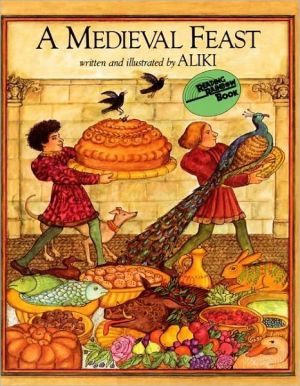

 |

|

The average rating for Medieval Feast based on 2 reviews is 3 stars.
Review # 1 was written on 2017-12-03 00:00:00 Annette Raab Annette RaabAlthough Aliki's A Medieval Feast does provide a basic and very much enlightening, informative representation of what a traditional European Mediaval feast would have both generally and specifically entailed (from the long and expensive preparations beforehand to the actual feasting itself, which usually took many many hours, often even days and obviously was the epitome of willful and wasteful decadence, with the consumption of vast amounts of different types of animal species, including large birds such as peacocks, cranes, swans and herons being one of the main and to me rather nauseating features) and while I did even to a certain point very much enjoy and appreciate both Aliki's text and her accompanying illustrations (pictorial images that are descriptive, colourful and delightfully detailed, both mirroring and often even expanding on the printed words, on the featured narrative), I for one have also felt more than a bit underwhelmed, as there is so much information that I do personally consider to be missing from A Medieval Feast or at the very least not having been sufficiently covered and explained by the author. Yes, A Medieval Feast is a book primarily conceptualised for and geared towards children (older children above the ages of eight or nine in my opinion, but still meant for children and not, say, young adults) and thus I certainly was not in any way expecting a detailed analysis of in particular feudalism within the text proper (within the actual narrative itself). However, I still was kind of expecting a bit more of an in depth analysis of the latter (of feudalism as a system) in the author's note, and the lack of this (that basically feudalism has not really been at all well enough explained, that it is never really all that much mentioned by Aliki that the serfs living on their lord's manor were basically indentured to him, were basically in many ways his slaves, and that the lord of the manor was also, in turn, indentured to the king, was the king's slave and could also therefore never really say "no" to the king coming to spend a few nights at the manor house during his travels, his so-called progresses) this all is for and to me a truly majorly frustrating academic shortcoming (not to mention that there is also NO bibliographical information whatsoever included, which really does make A Medieval Feast pretty well useless for any type of supplemental research and study). And thus, while I certainly have very much and appreciatively enjoyed especially the accompanying illustrations of A Medieval Feast, my personal frustrations with both the quality of the presented text (and specifically, in particular, with what has been left out, with what has not been more meticulously, more adequately explained in detail with regard to the entire concept of feudalism) and of course, the for and to me rather sadly unforgivable lack of supplemental reading suggestions, of any type of source acknowledgment, makes me grant only two stars at best and to also only recommend A Medieval Feast with some rather major reservations and caveats (although I do indeed appreciate Alicki's artistic renderings and actually do not even mind the presented narrative for what it is, but that still does not mean I can just accept and excuse what has been left out of A Medieval Feast as these types of intellectual failings, and especially with regard to not including any bibliographical information and references, period, in a historically and thus reality, non fiction dependent and based picture book, just do very massively and majorly rub me the wrong proverbial way). |
Review # 2 was written on 2016-11-22 00:00:00 Carlos Mendy Carlos MendyThe work that goes into preparing a banquet for a King is a costly and time-consuming event today, but back in the 1400s it would have been an overwhelming ordeal. Aliki has made such an event come alive in this colorful book. This is ideal to read aloud, and to do so more than once. The first time, it's sufficient to read the line of text on each page and look at the pictures. But if the child shows any interest in either the art or the text, it's easy to go deeper. Every detail in the pictures adds to the story of the labor, the setting, and the life style. Then, at the end of the book, there's a page of additional info for the interested reader. For example, on page 10 ... The text reads, They trapped rabbits and birds of all kinds, ... The art shows people, men and women, outside using various kinds of traps to catch the rabbits and birds. The caption built into the art reads, Serfs hid in bushes and caught birds in traps. And the border around the heart illustrates and labels various types of birds, including sparrow, eagle, curlew, blackbird, woodcock, lark, and mallard. We used to hear an advertising jingle about 'giving the gift that keeps on giving.' That applies to this book; there's always more to see if the reader keeps on looking. |
CAN'T FIND WHAT YOU'RE LOOKING FOR? CLICK HERE!!!